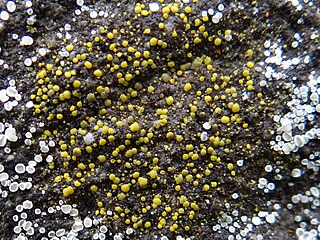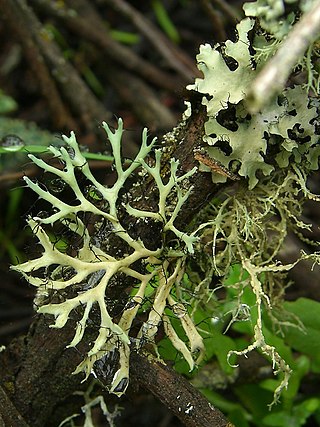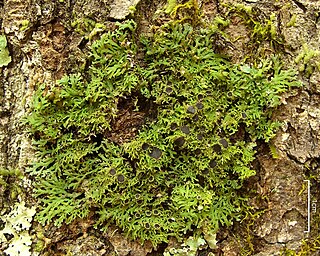
The Lecanoraceae are a family of lichenized fungi in the order Lecanorales. Species of this family have a widespread distribution.

The Physciaceae are a family of mostly lichen-forming fungi belonging to the class Lecanoromycetes in the division Ascomycota. A 2016 estimate placed 19 genera and 601 species in the family.

Lopadium is a genus of lichen-forming fungi in the monotypic family Lopadiaceae, which is in the order Lecideales. The genus contains 10 species. Lopadium was circumscribed by German lichenologist Gustav Wilhelm Körber in 1855.

Physconia is a genus of lichen-forming fungi in the family Physciaceae. It has about 25 species. The genus was circumscribed by Czech lichenologist Josef Poelt in 1965, with Physconia pulverulenta assigned as the type species.

Lecanactis is a genus of crustose lichens, commonly called old wood rimmed lichen. The genus was circumscribed in 1855 by German lichenologist Gustav Wilhelm Körber, who assigned Lecanactis abietina as the type species.

Lecidella is a genus of crustose lichens in the family Lecanoraceae.

Pyrrhospora is a genus of lichen-forming fungi in the family Lecanoraceae. The genus was circumscribed by German lichenologist Gustav Wilhelm Körber in 1855, with Pyrrhospora quernea assigned as the type species.
Harpidium is a genus of lichen-forming fungi in the family Harpidiaceae. The genus contains three species. Harpidium was circumscribed in 1855 by German lichenologist Gustav Wilhelm Körber, with Harpidium rutilans assigned as the type species.

Gyalecta is a genus of lichen-forming fungi in the family Gyalectaceae that contains 50 species. Gyalecta was circumscribed by lichenologist Erik Acharius in 1808.

Protoblastenia is a genus of lichens in the family Psoraceae. It was originally circumscribed by Alexander Zahlbruckner in 1908 as a section of genus Blastenia. J. Steiner promoted it to generic status in 1911.
Staurolemma is a genus of lichenized fungi in the family Pannariaceae. The genus was circumscribed by German lichenologist Gustav Wilhelm Körber in 1867, with Staurolemma dalmaticum as the type species.

Nesolechia is a genus of parasitic fungi in the family Parmeliaceae. All three species in the genus grow on lichens. Nesolechia probably evolved from a lichen ancestor, as it is closely related to many lichenized species of fungi.

Phacopsis is a genus of lichenicolous (lichen-dwelling) fungi. They are parasites of members of the large lichen family Parmeliaceae, of which they are also a member. Originally proposed by Edmond Tulasne in 1852 to contain 3 species, Phacopsis now contains 10 species, although historically, 33 taxa have been described in the genus. Many of the species are poorly known, some of them having been documented only from the type specimen.

Caliciales is an order of mostly lichenized fungi in the class Lecanoromycetes. It consists of two families: Caliciaceae and Physciaceae, which together contain 54 genera and more than 1200 species. The order was circumscribed by American botanist Charles Edwin Bessey in 1907.

Schaereria is a genus of lichen-forming fungi. It is the sole genus in the family Schaereriaceae, which itself is the only family in the Schaereriales, an order in the subclass Ostropomycetidae of the class Lecanoromycetes. Most Schaereria species are crustose lichens that live on rocks. Schaereria was first proposed by Gustav Wilhelm Körber in 1855 and was later taken up by other lichenologists despite periods of disuse.

Leucodermia is a genus of lichen-forming fungi in the family Physciaceae.
Tingiopsidium is a genus of lichen-forming fungi in the family Koerberiaceae. The genus was circumscribed in 1939 by French botanist Roger-Guy Werner, with Tingiopsidium pubescens assigned as the type species. Vestergrenopsis, a genus proposed by Vilmos Kőfaragó-Gyelnik in 1940, was shown to contain a species that is the type of Tingiopsidium, and because Tingiopsidium was published a year earlier, the principle of priority makes Vestergrenopsis illegitimate, and a synonym of Tingiopsidium.
Strangospora is a genus of lichen-forming fungi. It is the only genus in the family Strangosporaceae, which itself is of uncertain taxonomic placement in the Ascomycota. It contains 10 species.
Protothelenella is a genus of fungi in the family Protothelenellaceae. It contains 11 species, some of which form lichens. Protothelenella species have a crustose thallus with spherical to pear-shaped, dark brown to blackish perithecia. Microscopic characteristics of the genus include bitunicate asci with an amyloid tholus, and ascospores that are colourless and contain multiple internal partitions. Some species grow on acidic substrates including rocks, soil, bryophytes, plant detritus or rotten wood. Other species are lichenicolous (lichen-dwelling), growing on species of Solorina, Peltigera, Pseudocyphellaria, or Cladonia.

Kurokawia is a genus of lichen-forming fungi in the family Physciaceae. It has seven species of foliose lichens. The genus, circumscribed in 2021, has Kurokawia isidiata as the type species.















